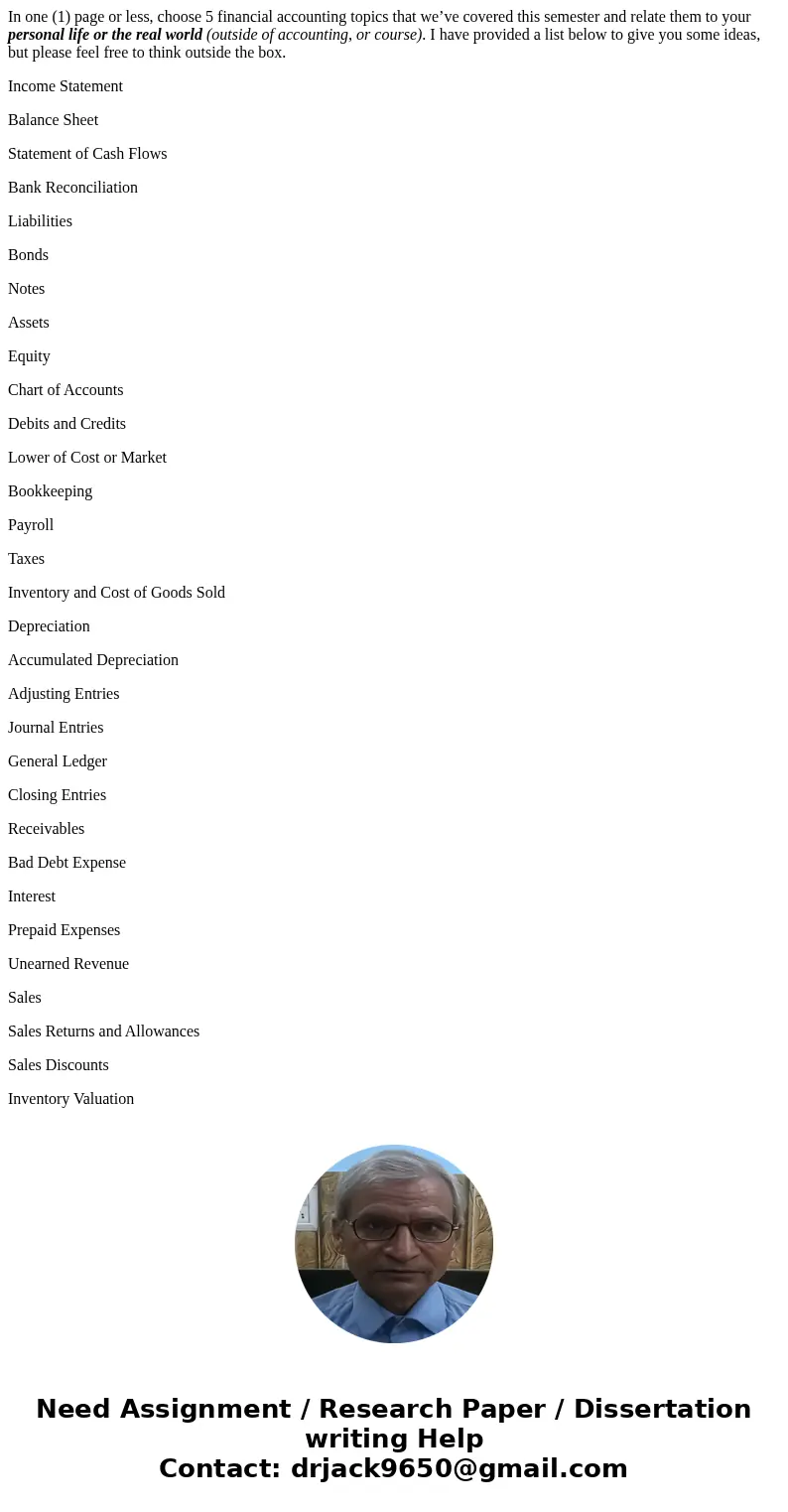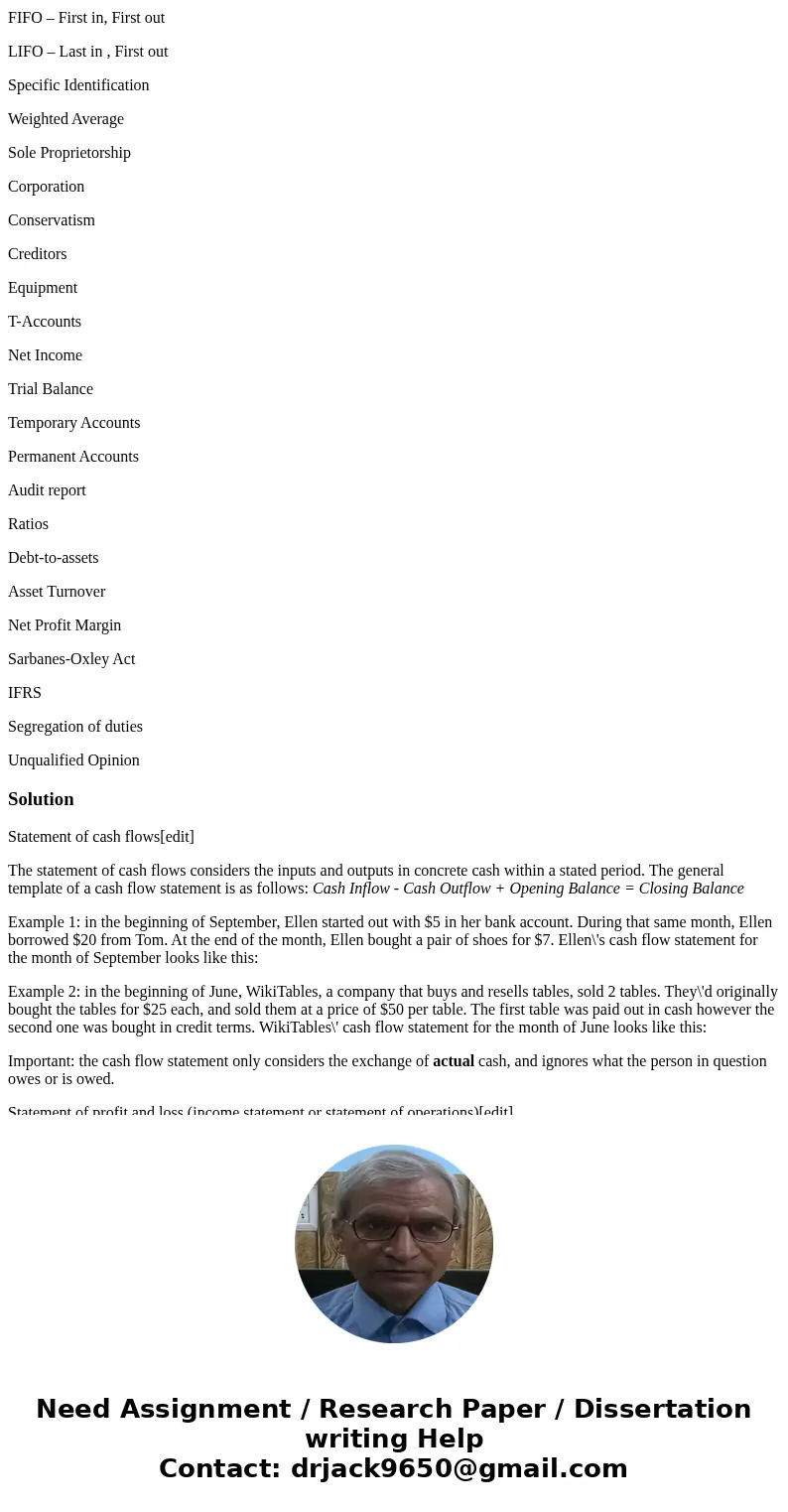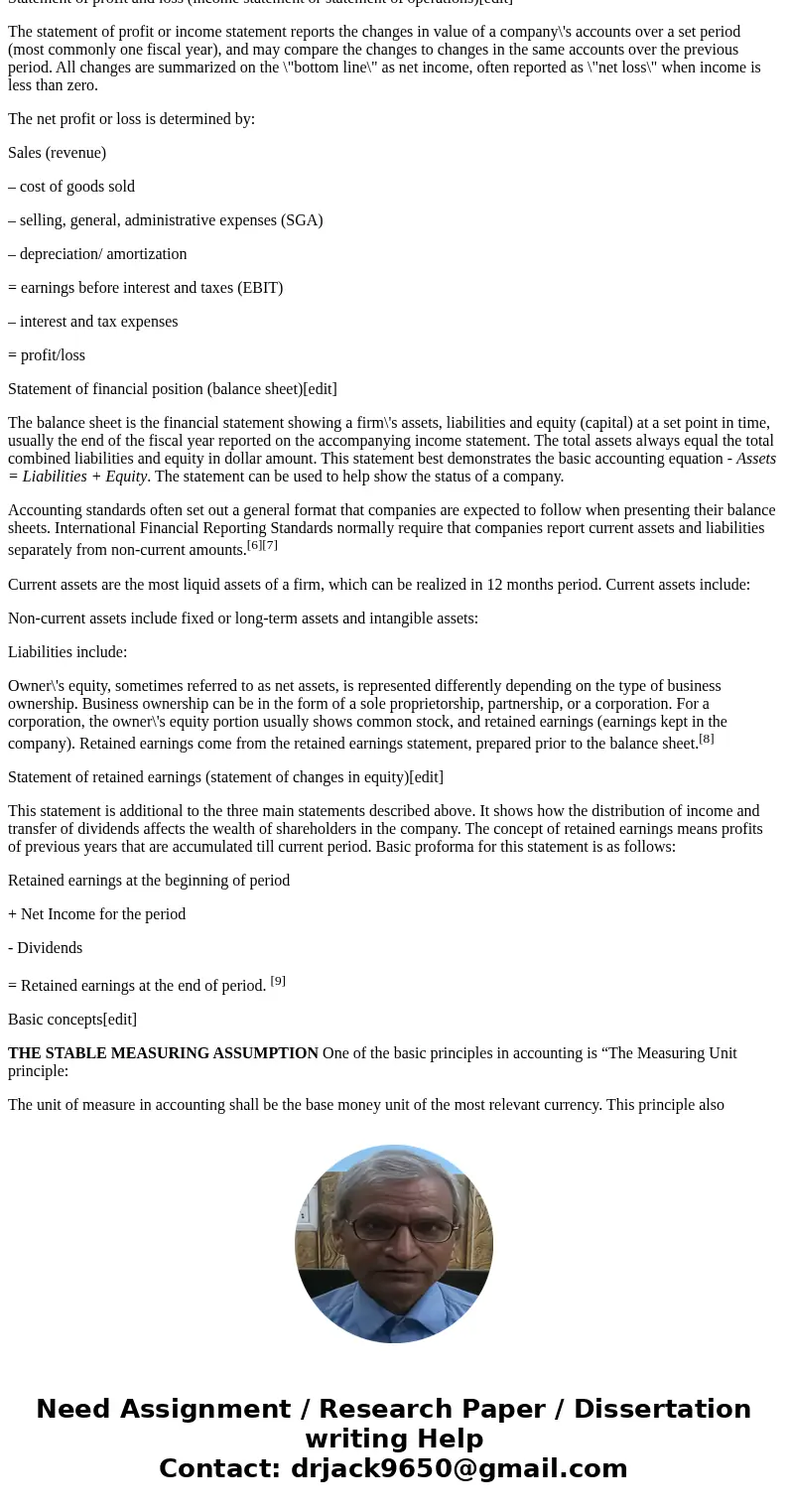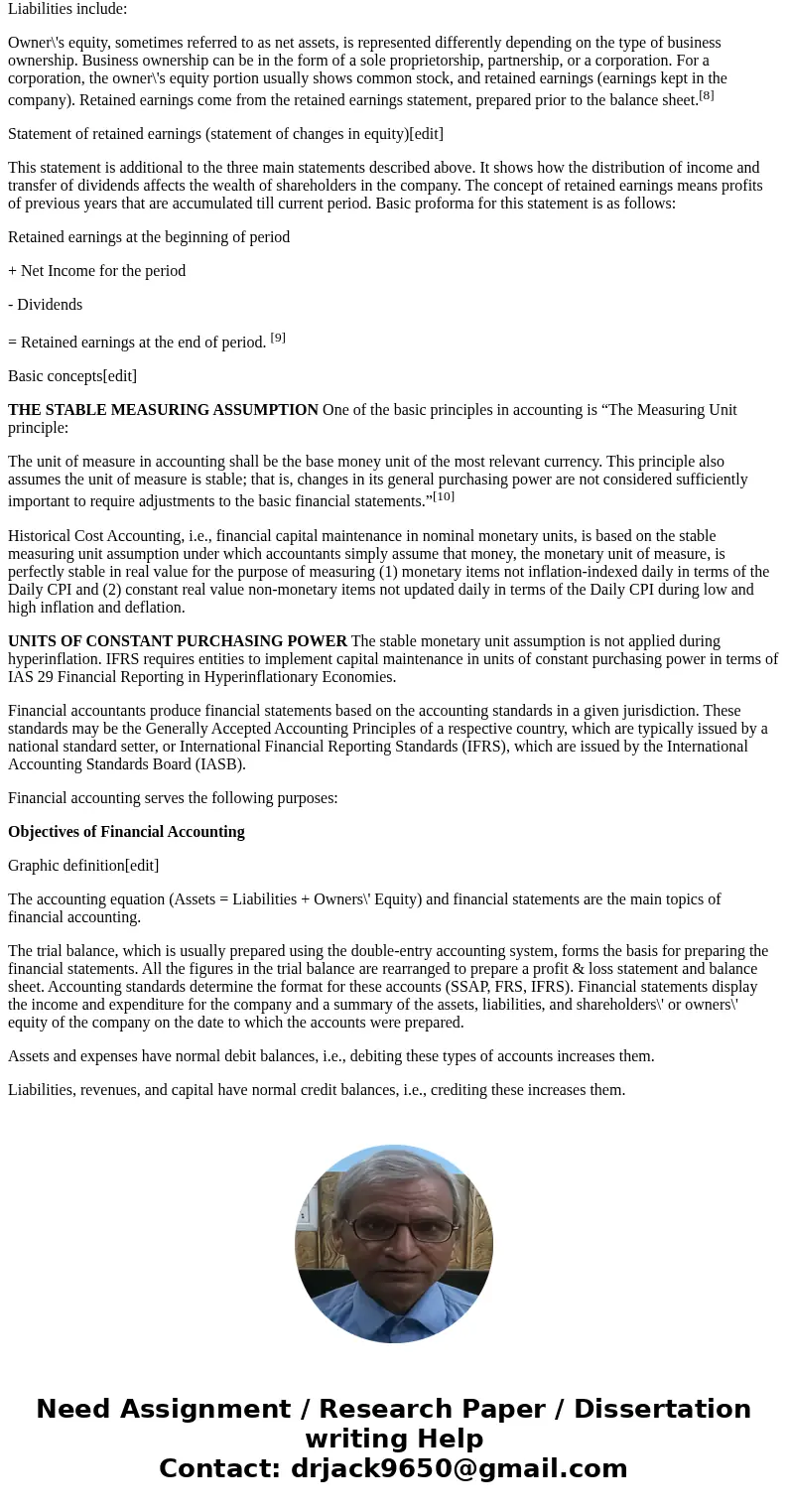In one 1 page or less choose 5 financial accounting topics t
In one (1) page or less, choose 5 financial accounting topics that we’ve covered this semester and relate them to your personal life or the real world (outside of accounting, or course). I have provided a list below to give you some ideas, but please feel free to think outside the box.
Income Statement
Balance Sheet
Statement of Cash Flows
Bank Reconciliation
Liabilities
Bonds
Notes
Assets
Equity
Chart of Accounts
Debits and Credits
Lower of Cost or Market
Bookkeeping
Payroll
Taxes
Inventory and Cost of Goods Sold
Depreciation
Accumulated Depreciation
Adjusting Entries
Journal Entries
General Ledger
Closing Entries
Receivables
Bad Debt Expense
Interest
Prepaid Expenses
Unearned Revenue
Sales
Sales Returns and Allowances
Sales Discounts
Inventory Valuation
FIFO – First in, First out
LIFO – Last in , First out
Specific Identification
Weighted Average
Sole Proprietorship
Corporation
Conservatism
Creditors
Equipment
T-Accounts
Net Income
Trial Balance
Temporary Accounts
Permanent Accounts
Audit report
Ratios
Debt-to-assets
Asset Turnover
Net Profit Margin
Sarbanes-Oxley Act
IFRS
Segregation of duties
Unqualified Opinion
Solution
Statement of cash flows[edit]
The statement of cash flows considers the inputs and outputs in concrete cash within a stated period. The general template of a cash flow statement is as follows: Cash Inflow - Cash Outflow + Opening Balance = Closing Balance
Example 1: in the beginning of September, Ellen started out with $5 in her bank account. During that same month, Ellen borrowed $20 from Tom. At the end of the month, Ellen bought a pair of shoes for $7. Ellen\'s cash flow statement for the month of September looks like this:
Example 2: in the beginning of June, WikiTables, a company that buys and resells tables, sold 2 tables. They\'d originally bought the tables for $25 each, and sold them at a price of $50 per table. The first table was paid out in cash however the second one was bought in credit terms. WikiTables\' cash flow statement for the month of June looks like this:
Important: the cash flow statement only considers the exchange of actual cash, and ignores what the person in question owes or is owed.
Statement of profit and loss (income statement or statement of operations)[edit]
The statement of profit or income statement reports the changes in value of a company\'s accounts over a set period (most commonly one fiscal year), and may compare the changes to changes in the same accounts over the previous period. All changes are summarized on the \"bottom line\" as net income, often reported as \"net loss\" when income is less than zero.
The net profit or loss is determined by:
Sales (revenue)
– cost of goods sold
– selling, general, administrative expenses (SGA)
– depreciation/ amortization
= earnings before interest and taxes (EBIT)
– interest and tax expenses
= profit/loss
Statement of financial position (balance sheet)[edit]
The balance sheet is the financial statement showing a firm\'s assets, liabilities and equity (capital) at a set point in time, usually the end of the fiscal year reported on the accompanying income statement. The total assets always equal the total combined liabilities and equity in dollar amount. This statement best demonstrates the basic accounting equation - Assets = Liabilities + Equity. The statement can be used to help show the status of a company.
Accounting standards often set out a general format that companies are expected to follow when presenting their balance sheets. International Financial Reporting Standards normally require that companies report current assets and liabilities separately from non-current amounts.[6][7]
Current assets are the most liquid assets of a firm, which can be realized in 12 months period. Current assets include:
Non-current assets include fixed or long-term assets and intangible assets:
Liabilities include:
Owner\'s equity, sometimes referred to as net assets, is represented differently depending on the type of business ownership. Business ownership can be in the form of a sole proprietorship, partnership, or a corporation. For a corporation, the owner\'s equity portion usually shows common stock, and retained earnings (earnings kept in the company). Retained earnings come from the retained earnings statement, prepared prior to the balance sheet.[8]
Statement of retained earnings (statement of changes in equity)[edit]
This statement is additional to the three main statements described above. It shows how the distribution of income and transfer of dividends affects the wealth of shareholders in the company. The concept of retained earnings means profits of previous years that are accumulated till current period. Basic proforma for this statement is as follows:
Retained earnings at the beginning of period
+ Net Income for the period
- Dividends
= Retained earnings at the end of period. [9]
Basic concepts[edit]
THE STABLE MEASURING ASSUMPTION One of the basic principles in accounting is “The Measuring Unit principle:
The unit of measure in accounting shall be the base money unit of the most relevant currency. This principle also assumes the unit of measure is stable; that is, changes in its general purchasing power are not considered sufficiently important to require adjustments to the basic financial statements.”[10]
Historical Cost Accounting, i.e., financial capital maintenance in nominal monetary units, is based on the stable measuring unit assumption under which accountants simply assume that money, the monetary unit of measure, is perfectly stable in real value for the purpose of measuring (1) monetary items not inflation-indexed daily in terms of the Daily CPI and (2) constant real value non-monetary items not updated daily in terms of the Daily CPI during low and high inflation and deflation.
UNITS OF CONSTANT PURCHASING POWER The stable monetary unit assumption is not applied during hyperinflation. IFRS requires entities to implement capital maintenance in units of constant purchasing power in terms of IAS 29 Financial Reporting in Hyperinflationary Economies.
Financial accountants produce financial statements based on the accounting standards in a given jurisdiction. These standards may be the Generally Accepted Accounting Principles of a respective country, which are typically issued by a national standard setter, or International Financial Reporting Standards (IFRS), which are issued by the International Accounting Standards Board (IASB).
Financial accounting serves the following purposes:
Objectives of Financial Accounting
Graphic definition[edit]
The accounting equation (Assets = Liabilities + Owners\' Equity) and financial statements are the main topics of financial accounting.
The trial balance, which is usually prepared using the double-entry accounting system, forms the basis for preparing the financial statements. All the figures in the trial balance are rearranged to prepare a profit & loss statement and balance sheet. Accounting standards determine the format for these accounts (SSAP, FRS, IFRS). Financial statements display the income and expenditure for the company and a summary of the assets, liabilities, and shareholders\' or owners\' equity of the company on the date to which the accounts were prepared.
Assets and expenses have normal debit balances, i.e., debiting these types of accounts increases them.
Liabilities, revenues, and capital have normal credit balances, i.e., crediting these increases them.




 Homework Sourse
Homework Sourse